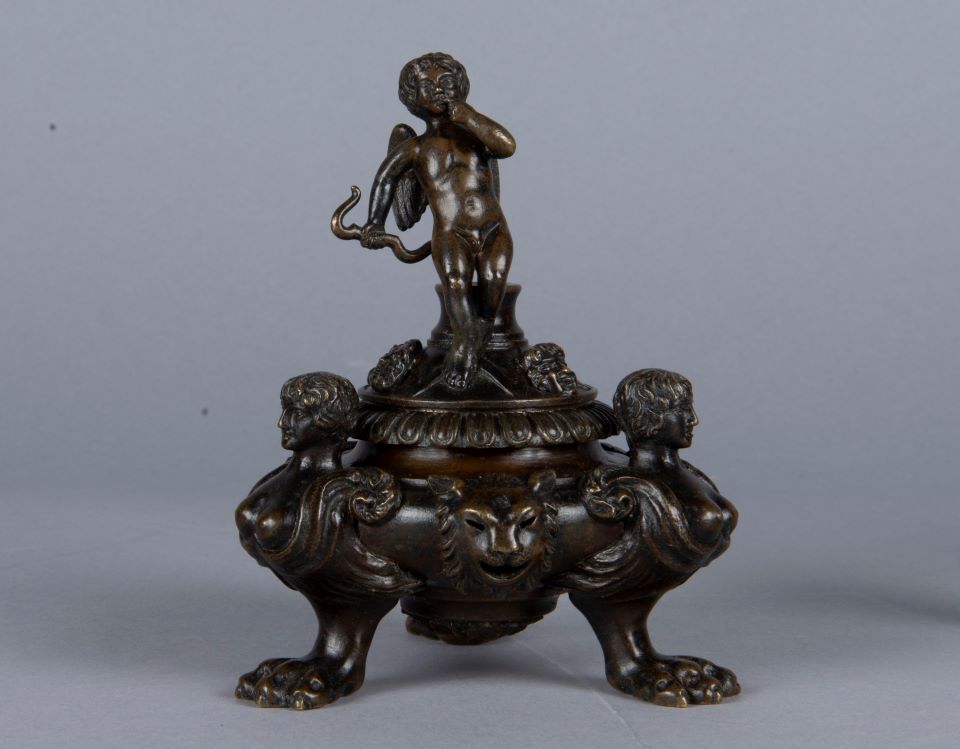News Release

NPS Photo / Joannie Bottkol
|
Subscribe
|
Contact: David Daly, 617-876-4491
A 19th century inkstand passed from writer to writer before landing on Henry Wadsworth Longfellow’s desk. A decorative cupid figurine broken off the top of the inkstand and lost for nearly a century before a remarkable rediscovery. For such a small object, this bronze inkstand has many stories to tell.
The inkstand boasts an impressive lineage of writers associated with it: Petrarch. Ludovico Ariosto. George Crabbe. Thomas Moore. Samuel Carter Hall. Henry Wadsworth Longfellow.
Some claim that the bronze inkstand on Longfellow’s desk today is a copy of “Petrarch’s inkstand,” which became a popular souvenir of early 19th century tourism. The surviving copies of “Petrarch’s Inkstand” are clearly like Longfellow’s inkstand, but with distinct differences in their covers and depictions of cupid. However, cupid’s pose and the cover on Longfellow’s inkstand match a different 19th century Italian travel souvenir: Ludovico Ariosto’s inkstand.
According to late 19th century sources, the inkstand that sits on Longfellow’s desk today was presented to English poet George Crabbe at a party. The inkstand’s association with George Crabbe came to overshadow it being “Ariosto’s” inkstand. Following Crabbe’s death in 1832, Irish poet Thomas Moore wrote “Verses To The Poet Crabbe's Inkstand.” Moore acquired the inkstand, and after his death, Moore’s widow bequeathed the inkstand to yet another writer: editor and literary critic Samuel Carter Hall. According to Samuel Longfellow (the poet’s brother), Hall’s wife used this inkstand daily, but after her death Hall sent the inkstand to the final writer to own it: Henry Wadsworth Longfellow.
The inkstand was part of the original collection entrusted to the National Park Service in the 1970s, but without the striking bronze cherub atop the cover. The cherub appears in photographs from the early 20th century but is missing from photographs of Longfellow’s study by the 1940s. What happened to cupid?
For decades, cupid’s whereabouts remained a mystery, but in 2017 a donor came forward with the missing cupid and an amazing story. A relative who had worked for the Longfellow family accidentally broke the inkstand while cleaning. Frightened, the cleaner kept the small bronze cupid.
The donor returned cupid to the Longfellow House in 2017. However, the figure was tremendously difficult to reattach. Enter objects conservator Jonnie Bottkol in 2021, who with support of Friends of Longfellow House-Washington’s Headquarters, Inc, reattached the cupid with a stainless-steel pin and conserved the entire inkstand. In the process, Bottkol discovered that cupid had, in fact, broken off at least once before it was lost in the early 20th century.
“This tremendous tale of a precious object’s return to splendor is a testament to not one, but two civic-minded donors,” said Longfellow House Site Manager Chris Beagan. “The site is deeply grateful to the relative who rediscovered cupid and to the Friends of Longfellow House-Washington’s Headquarters Inc. for funding conservation of the inkwell.”
Today, the inkstand is once again surmounted by a free-standing figure of cupid holding a bow in one hand with the other hand pressed to his lips, holding the past’s secrets. The inkstand will be on permanent exhibit in Henry Longfellow's study when Longfellow House-Washington’s Headquarters National Historic Site reopens in spring 2022.
Last updated: March 24, 2022
